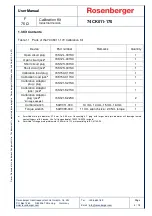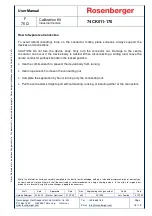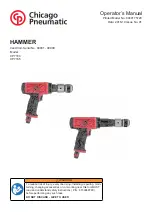
User Manual
F
75
Ω
Calibration Kit
Industrial Version
74CK011-170
Rosenberger Hochfrequenztechnik GmbH & Co. KG
P.O.Box 1260 D-84526 Tittmoning Germany
www.rosenberger.com
Tel. : +49 8684 18-0
Email : [email protected]
Page
6 / 15
D
ie
s
e
s
D
o
k
u
m
e
n
t
is
t
u
rh
e
b
e
rr
e
c
h
tl
ic
h
g
e
s
c
h
ü
tz
t
●
T
h
is
d
o
c
u
m
e
n
t
is
p
ro
te
c
te
d
b
y
c
o
p
y
ri
g
h
t
●
R
o
s
e
n
b
e
rg
e
r
H
o
c
h
fr
e
q
u
e
n
z
te
c
h
n
ik
G
m
b
H
&
C
o
.
K
G
2. Specifications
2.1 Environmental Requirements
The electrical performance of vector network analyzers and test port cables are sensitive to
ambient temperature drift. Most manufacturers limit the allowable temperature drift to ± 1 K during
measurement calibration and during measurements when the network analyser error correction is
turned on. For further information please refer to the VNA specifications.
NOTE: With your fingers being a heat source, avoid unnecessarily handling the devices
during calibration.
The calibration standards are less sensitive to temperature changes. The operating temperature
range for which the specifications are valid is defined in the specific data sheets.
2.2 Electrical and mechanical Specifications
Electrical and mechanical specifications are defined for all calibration standards in the specific data
sheets.
3. Standard Definitions
3.1 Standard Definitions
Standard definitions provide the data needed to mathematically describe the electrical charac-
teristics of each calibration standard. For this calibration kit standard definitions are available:
•
Model based
(standard delivery): These are the traditional standard definitions and can be
used on both old and modern VNAs. The values of these constants are theoretically derived
from the physical dimensions and material of each calibration standard, or from actual
measured response. All necessary values are printed on the Standard Definition Cards and
stored as data files on an USB stick. Both are included with this calibration kit.
These standard definitions are used in the calibration of the VNA to determine the systematic
errors of the measurement system. Please always use the most recent source of information
(Standard Definitions Cards or VNA specific files).

































